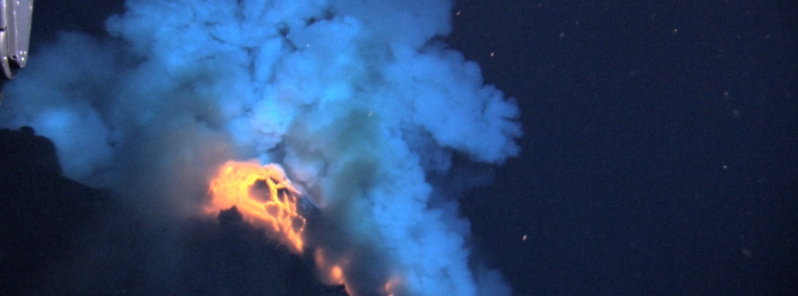Underwater volcanoes release enough energy to power a continent

Submarine volcanoes or those deep in our oceans can release extremely powerful energy, high enough to power a continent, new research suggests. It was previously believed that underwater volcanoes were much less violent than those on land due to relatively slow-moving lava flows.
New data collected by submersibles in the North East Pacific show that submarine volcanoes can release powerful megaplumes, distributing volcanic ash across wide underwater distances.
The megaplumes are formed by large, fast-moving columns of heated water. They follow similar movement patterns to plumes generated by volcanic eruptions on land– moving upward first and then horizontally spreading out.
The researchers estimated that the megaplumes produced by large underwater eruptions have enough water to fill about 40 million Olympic-sized swimming pools.
While scientists have detected megaplumes before, their source remained a mystery. The findings are the first to link the phenomenon with the release of magma from a huge submarine volcano.
To further understand the scope of underwater volcanic eruptions, the researchers came up with a simulation, which showed that the release of energy needed to generate such expansive ash was enormous. The largest eruptions could release energy high enough to power a continent, they added.

Image: Superheated molten lava about to explode into the water. Credit: NOAA/National Science Foundation
"The majority of Earth's volcanic activity occurs underwater, mostly at depths of several kilometers in the deep ocean but, in contrast to terrestrial volcanoes, even detecting that an eruption has occurred on the seafloor is extremely challenging," said co-author David Ferguson, a geochemist studying magmatic processes at the University of Leeds in Britain.
"Consequently, there remains much for scientists to learn about submarine volcanism and its effects on the marine environment."
Co-author Sam Pegler stated, "Our work provides evidence that megaplumes are directly linked to the eruption of lava and are responsible for transporting volcanic ash in the deep ocean. It also shows that plumes must have formed in a matter of hours, creating an immense rate of energy release."
In the future, scientists hope to use remote-sensing technologies to livestream observations of underwater volcanoes as they are happening.
Reference
"Rapid heat discharge during deep-sea eruptions generates megaplumes and disperses tephra" – Pegler, S. S., & Ferguson, D. J. – Nature Communications – DOI: 10.1038/s41467-021-22439-y
Abstract
Deep-marine volcanism drives Earth’s most energetic transfers of heat and mass between the crust and the oceans. While magmatic activity on the seafloor has been correlated with the occurrence of colossal enigmatic plumes of hydrothermal fluid known as megaplumes, little is known of the primary source and intensity of the energy release associated with seafloor volcanism. As a result, the specific origin of megaplumes remains ambiguous. By developing a mathematical model for the dispersal of submarine tephras, we show that the transport of pyroclasts requires an energy discharge that is sufficiently powerful (~1-2 TW) to form a hydrothermal plume with characteristics matching those of observed megaplumes in a matter of hours. Our results thereby directly link megaplume creation, active magma extrusion, and tephra dispersal. The energy flux at the plume source required to drive the dispersal is difficult to attain by purely volcanogenic means, and likely requires an additional input of heat, potentially from rapid evacuations of hot hydrothermal fluids triggered by dyke intrusion. In view of the ubiquity of submarine tephra deposits, our results demonstrate that intervals of rapid hydrothermal discharge are likely commonplace during deep-ocean volcanism.
Featured image credit: NOAA/National Science Foundation

Uploaded more than three years ago, our video explains volcanic eruptions are the source of our ocean waters – our video is titled:
Where Do Our Ocean Waters Come From?
https://www.youtube.com/watch?v=8y_6sGaxMAw
In a separate video, we explain why sea levels have remained relatively stable over the past several decades as glaciers rapidly melt – worldwide.
The claims of this research paper are wrong. If one takes into account the actual number of submarine volcanoes and their sizes which are much bigger than land volcanoes, then it will be obvious that the energy release from these volcanoes can power the whole world not just a continent and for indefinite time.